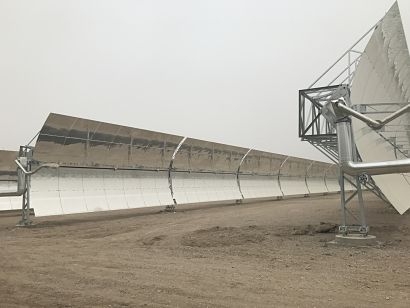
ABB is supporting the Chinese solar energy programme by delivering digital solutions for concentrated solar power (CSP) projects, having already supported the 50 MW Delingha facility in collaboration with China General Nuclear Power Group in late 2018.
This second plant is the first of its kind in Inner Mongolia, and one of the largest capacity solar parabolic projects in China’s 20 pilot plant initiative at 500 hectares. It is set to save approximately 90,000 tons of coal per year.
“We are delighted to have been awarded a second project to deliver our digital solutions as part of the 20 pilot CSP solar programme, aimed at boosting China’s efforts to meet the 2030 target of producing 20 per cent of its overall electricity from renewable sources” said Kevin Kosisko, Managing Director, Energy Industries, ABB. “As a digital leader in the energy transition, ABB offers innovative digital solutions that are future-focused. This is complemented by our customer focus and heritage in intelligent project delivery, ensuring confidence in ABB as an automation provider.”
A spokesperson of China Shipbuilding New Power Co. Ltd added that the company chose ABB to deliver the project because of their expertise as a world-leading supplier of integrated electrical and automation systems for CSP plants.
ABB will deploy its flagship ABB Ability Symphony Plus distributed control system (DCS), incorporating a power island, heat storage and transfer, as well as auxiliary controls, and co-ordination control of solar fields. The distributed control system (DCS) will unify all the plant’s production processes into a single user-friendly system, including the heat transfer system, which transports the heat to molten salt tanks where it is stored, and the power block where the electricity is generated and fed into the transmission grid. ABB Ability Symphony Plus is the world’s market-leading distributed control and SCADA system for the power generation and water industries.
With over 174 GW solar power generation capacity in 2018, China is now the leading producer of solar power globally. The Chinese government has provided more than $430 million in subsidies new solar power projects over the past year and is considering various efficient technologies to harness energy from the sun. CSP technology, unlike Photovoltaics (PV), concentrates radiation from the sun, and converts light into heat, which drives an engine that connects to an electric generator. Whereas PV does not store heat, thermal energy from CSP can be stored to help overcome intermittency issues, due to the availability of sun or environmental fluctuation.
The greenfield project led by China Shipbuilding New Power Co. Ltd and supported by over $368 million of investment is anticipated to be delivered soon.
For additional information:

